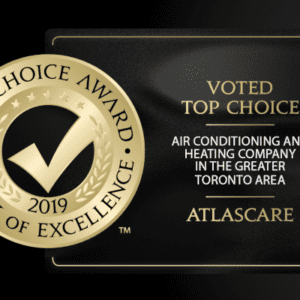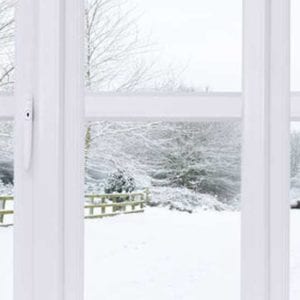Between an unstable global fuel market and battles over energy policy back home, there’s no telling exactly how Canada’s energy future will unfold. What we do know is this: the cost of natural gas or electricity will continue to fluctuate, and there’s not much that Ontario homeowners can do about it.
What you can do is take steps future-proof your home against rising home energy prices.
Planning home upgrades and renovations with a mind to the future has been shown to save hundreds or even thousands in energy costs year after year. And if you live in Ontario, where heat is by far the biggest energy expense for most families, the ‘H’ in ‘HVAC’ is the best place to start.
Let’s look at the various options you have when it comes to future-proofing your home against rising gas and electricity costs in Ontario and beyond.
1. Smart Home Technology
It’s incredible to think how much smart home technology has evolved in the past decade. What began as a novelty has grown to become an integral part of millions of homes worldwide.
Today, we build many new houses to use smart technology from the ground up. But there are also many ways to rewire an existing home to integrate smart home technology, including smart Wi-Fi thermostats.
When it comes to future-proof home, a smart thermostat is a must. Products like the Nest, Honeywell Evohome, Lennox iComfort and ecobee smart thermostats are a powerful ally in the fight against rising utility bills.
How does smart home heating work? Each smart thermostat model has unique features and functions, but they share many of the same benefits across the board:
- Cost savings. The biggest selling point of a smart Wi-Fi thermostat is that it enables you to easily monitor and control your energy usage, empowering you to strategically manage your heating system to reduce costs.
- Fewer breakdowns. The constant feedback available with smart thermostats can alert you early on to potential furnace maintenance issues. The sooner you notice and address these issues, the less likely you are to need an emergency furnace repair call.
- Increased home value. Having a smart-ready home makes your home technologically relevant and appealing to the next generation of home buyers.
Depending on the age of your home, chances are your original furnace or boiler wasn’t wired serve as a platform for smart home technology. However, many newer models are made with smart thermostats in mind. Be sure to consider the value of smart home tech when you’re considering your next heating upgrade.
2. High-Efficiency Furnaces and Boilers
Today, most homes in Ontario are heated in one of two ways: a forced-air furnace or a hydronic system powered by a boiler. Forced air heating is the standard in most newer builds.
The efficiency of a furnace or boiler is measured by the annual fuel utilization rate, better known as the AFUE, which tells you the ratio of the unit’s actual heat output compared to its energy usage. A furnace with a 90% AFUE, for instance, turns 90% of its energy consumption into heat – the remaining 10% goes out through the chimney.
Why is the AFUE rating important? Because when it comes to rising energy costs, every bit of wasted energy counts towards higher utility bills. The higher the AFUE, the greater the benefits of energy efficiency.
- Older, low-efficiency furnaces typically have an AFUE of 56% to 70%, which means about a third of the money spent heating the home goes to waste. That could count for hundreds of dollars each winter and thousands over the lifetime of the unit.
- Compared that to current high-efficiency systems, which boast up to 98.5% AFUE, and it’s clear why a higher-efficiency heating unit is a future-proofing essential.
It’s important to note, however, that a bigger furnace isn’t necessarily a more efficient one for your home. A properly-sized furnace or boiler will almost always be more efficient than an oversized one, even if the more powerful unit is technically higher in AFUE. When buying a new furnace, you should always consult a trustworthy heating contractor to help you choose the right size of unit.
3. Duct Sealing
If you’re thinking of future-proofing your home with a higher-efficiency forced air furnace, there’s one other step you should take at the same time: air duct sealing.
The AFUE rating of a furnace doesn’t account for heat loss that occurs through holes in the ductwork or piping – which can account for as much as 35% of the unit’s energy output, according to ENERGY STAR. That means up to 35% of the warm air ends up in unheated spaces instead of the living space.
If the heated air can’t reach its destination, the potential cost-savings of an energy-efficient heating system are significantly lower.
4. Increased Insulation
You might be surprised to learn the impact insulation can have on your heating bills. Walls can account for 20% of a home’s heat loss, even before you count air leakage through cracks and gaps.
The criteria for effective insulation is threefold: it must successfully resist heat flow, fill the space completely and evenly, and be durable enough to provide years of dependability. Additionally, for some locations, it must withstand exposure to heat and moisture.
If you’re not sure what kind of insulation you have, or you don’t know when it was installed, it’s time to give your walls a second look. Replacing outdated, ineffective insulation is a necessity when it comes to keeping heating costs low. Along with being more efficient, newer types of insulation have the added benefit of being less toxic.
5. Energy-Efficient Windows
We don’t often think of windows when we talk about innovation and efficiency, but we should. Windows (and skylights) are often one of the biggest sources of heat loss. In some cases, it accounts for a whopping 30% of the home’s overall energy loss.
Part of this loss stems from radiant heat transfer – when heat hits the window, it transfers some of its energy to the cold air outside. The other source of heat loss is air escaping through windows is through the small, often invisible gaps between the window frame and the home’s envelope. Future-proofing your home will require you to tackle both issues.
The simplest way to cut radiant heat loss through windows is to add thick, energy-efficient window treatments that act as an extra layer of insulation. That’s a good interim solution until you’re ready to replace the windows with energy-efficient models, which is where you’ll see real energy savings.
- Compared to standard windows, choosing ENERGY STAR-certified models can save an extra 8% on your home heating bills. Look for windows with low-e glass or low-e window coatings.
- The cost of low-e windows is higher than standard ones, but they pay back energy savings by reflecting heat energy back into the living space when it hits the glass.
- Some models also come with inert gasses between the panes instead of air for better insulation.
When window shopping, it’s important to look at the product’s intended Climate Zone. Southern Ontario sits in Climate Zone 2. If you purchase windows rated for Zone 1, you might find it doesn’t insulate as well as advertised.
What About Alternative Heating Technologies?
It’s hard to know exactly where things will go when it comes to alternative and renewable heating technologies in Canada.
Several years ago, for instance, policymakers in Ontario saw heat pumps as the ideal heating solution. However, despite the potential benefits of this technology, heat pumps haven’t been adopted as readily by consumers as expected – and the number of rebates available for heat pumps has declined.
But that doesn’t mean that newer heating technologies aren’t worth considering. In fact, there are more options than ever when it comes to future-proofing your home’s heating system with innovative and efficient alternatives.
Heat pumps, which move heat energy from one space to another instead of generating it, are like a furnace and air conditioner in one. Air-source heat pumps provide warmth by moving heat from the cool outdoor air into the home. It’s always possible to extract some heat energy from the air, even in the coldest Canadian winter.
During the summer, heat pumps reverse the process to cool the air. Although heat pumps cannot replace furnaces in most parts of Canada (most experts agree heat pumps are inadequate in temperatures below -15°C), they work well as a source of back-up heat and a replacement for air conditioning.
Solar heating is another intriguing option that has grown significantly in recent years. Active solar heat systems use solar energy to heat liquid or air, then transfer it into the interior space or a storage system for later use.
An active solar heating system can be combined with a radiant floor system, forced-air system or water heater to distribute supplementary solar heat. It presents an opportunity to put Ontario’s abundant solar resources to use and supplement your existing heating system with renewable energy.
A Solution for Rising Energy Costs in Ontario
Future-proofing won’t look the same for every home in Ontario. The best solution for you might not be the same as that of your friend across town, and it might even look different from your next-door neighbour’s.
Proper, well-founded future-proofing takes considering into where you live, your home’s age and structure, your family’s unique needs, and the systems already in place. Together, these factors inform which solutions will work best together to provide you with long-term value and comfort.
Any time you’re considering changes to your home heating system, it always pays to have input from home comfort specialists. Contact our team for information about heating installation and services your home in the Greater Toronto Area.








